Stryker Triathlon Total Knee Replacement System
|
|
|
|
Triathlon CR Knee Replacement Components |
Triathlon CS Knee System |
|
|
|
|
Triathlon Instrument Case |
Triathlon PS Knee System |
Triathlon Knee System Anterior Referencing Surgical Protocol:
http://www.gkqcw.cn/gkqcwload2.asp?id=222
Triathlon Surgical Protocol:
http://www.gkqcw.cn/gkqcwload2.asp?id=223
Let's Talk Science Tiathlon Knee System Product Brochure; Learn How Triathlon Was Designed with Women in Mind Product Guide;Triathlon Knee System with Peri-Apatite Product Brochure:
http://www.gkqcw.cn/gkqcwload2.asp?id=224
Features & Benefits:
1、Implants
(1) Improved Motion:
• Design features such as a patent pending anatomic radius, deep flexion radius and flared posterior condyles, as well as Rotary Arc and anatomic patellofemoral track allow the Triathlon Knee System to maintain substantial contact area throughout the entire range of motion.
Anatomic Radius
Studies of kinematics and biomechanics have identified a constant radius in natural knee motion centered about the transepicondylar axis.1,2
The Triathlon Knee Sy stem is the first of its kind with a patented anatomic radius. Centering the anatomic radius about the transepicondylar axis provides ligament isometry, not only in full extension and 90-degrees of flexion, but through the entire range of motion. Triathlon's anatomic radius is designed to mimic natural knee motion, enhancing stability and mobility in activities such as descending and ascending stairs, gardening, or any similar activity requiring stability at deep flexion angles.
References:
1. Hollister AM, Jatana S, Singh AK, Sullivan WW, Lupichuk AG. The axes of rotation of the knee. Clin Orthop. 1993 ;(290):259-68. http://www.gkqcw.cn/gkqcwload2.asp?id=213
2. Churchill DL, Incavo SJ, Johnson CC, Beynnon BD. The transepicondylar axis approximates the optimal flexion axis of the knee. Clin Orthop. 1998 ;(356):111-8 http://www.gkqcw.cn/gkqcwload2.asp?id=214

Anatomic Radius
• The deep flexion features of the components are designed to optimize rotation in deep flexion without sacrificing stability.
Deep Flexion Radius and Flared Posterior Condyles
The shorter posterior condyles facilitate the relaxation of soft-tissues to enable deep flexion. The condylar geometry is designed to allow for rapid flexion, enhanced contact area and natural knee rotation through 150+ degrees of flexion.
Flaring the posterior condyles accommodates increased angles of tibial rotation as the knee approaches deep flexion, culminating in up to 20 degrees of rotation while maintaining excellent contact area.
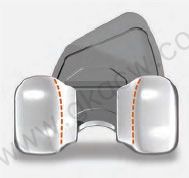
Deep Flexion Radius and Flared Posterior Condyles
• The femoral geometry in conjunction with the Rotary Arc accommodate increasing amounts of internal/external rotation as necessitated by greater degrees of flexion.
Rotary Arc
Natural tibial rotation is optimized through the unique Rotary Arc, that allows internal and external rotation about a central pivot. A proprietary four-axis machining process creates a tibiofemoral design that facilitates conforming, yet functionally constrained articulation.
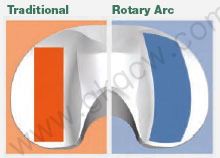
Traditional fixed bearing insert designs (above left) machine linear articulation troughs. The Triathlon Knee System four-axis machining process adds rotational capability to a fixed bearing insert (above right).
(2)Better Fit2:
• Size offerings are based on an anthropometric measurement study for optimal interplay between implant geometry and anatomic structure.
Anthropometrically-Based Design
The Triathlon Knee System sizing options are based on an anthropometric study for an optimized interplay between implant and anatomic structure. With eight sizes growing by no more than 3mm in the sagittal plane, the closely linked dimensions of the components offer better fit to a wider spectrum of patients.
The Triathlon Knee System addresses smaller anatomies, often found in female patients, heavily concentrated in the region shown, while still accommodating larger patient sizing requirements.
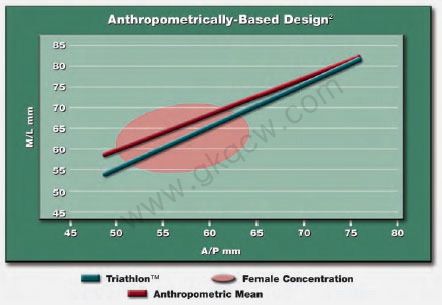
• Offers a broader range of tibiofemoral sizing options to meet the anatomic realities of TKA.
• A 7-degree anterior flange is designed to enable downsizing with lower incidence of notching.
• The forgiving design aspects of the implant accommodates surgical realities.
(3)Reduced Wear3 / Potential for Greater Implant Longevity :
• Designed to limit contact stresses even in adverse conditions.
• A precision insert locking mechanism and Anti-Rotation Island inhibits insert micromotion and increases insert/tibial tray surface contact area - all designed to decrease the likelihood of backside wear.
Insert Fixation System
The locking mechanism of the Triathlon Knee System features a complete peripheral rim-locking mechanism between the tibial baseplate and insert. An Anti-Rotation Island is designed to reduce micromotion (A/P and M/L) and increase backside contact area, further enhancing the insert fixation system. These features, in conjunction with reduced articular stresses, work together to minimize the clinical challenges of micromotion that have been shown to lead to backside wear.1
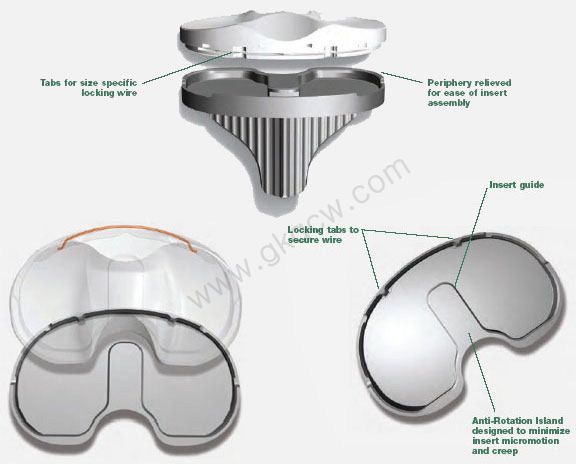
Insert Fixation System
References
1. Rao AR, Engh GA, Collier MB, Lounici S. Tibial interface wear in retrieved total knee components and correlations with modular insert motion. J Bone Joint Surg Am. 2002 Oct;84-A(10):1849-55.
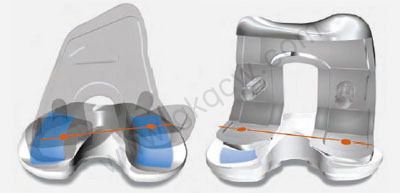
Decreased Articular Forces
2、Instruments :
(1)Efficiency
The Triathlon Knee System Instrumentation design team focused on identifying ways to increase the accuracy and simplicity of the surgical procedure; two variables that may affect OR efficiency.
The features incorporated include:
• Open design cutting blocks to enhance visualization.
• Bold markings and color coding for ease of use and clear identification.
• Quick attach and release mechanisms to facilitate easy assembly.
• A logically organized tray layout based on the operational sequence for a streamlined process.
(2)Flexibility
The proprietary instrumentation design also delivers intra-operative flexibility. The following features accommodate surgical preferences and help surgeons adapt to multiple surgical realities
• System modularity facilitates a customized surgical flow.
• A common platform that is designed to allow for seamless intraoperative transitions.
• Navigation ready.
• Minimal incision capability.
(3)Orthonomic Features
The Triathlon Knee System Instrumentation is designed to be the new gold standard in the industry. Advanced design principles incorporating Orthonomic features include:
• Ergonomic soft grip handles for optimized fit and comfort.
• Instrument surface treatment for reduced glare and enhanced readability.
• Procedural enhancing mechanisms.
• Lightweight trays for ease of handling.
References
Hitt, K., et al. Anthropometric Measurement of the Human Knee: correlation to the Sizing of Current Knee Arthroplasty Systems, J Bone Joint Surg Am. 2003;85(Supplement 4 ):115-122.
If you want to read the references, please contact with our website.